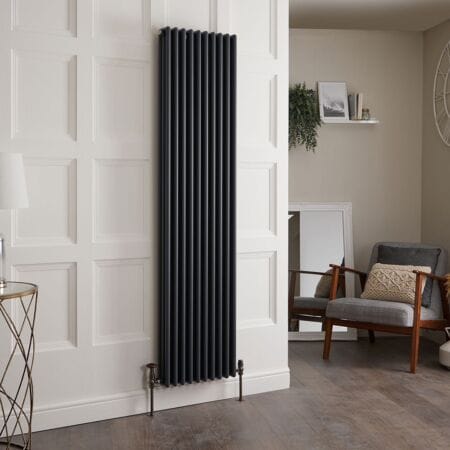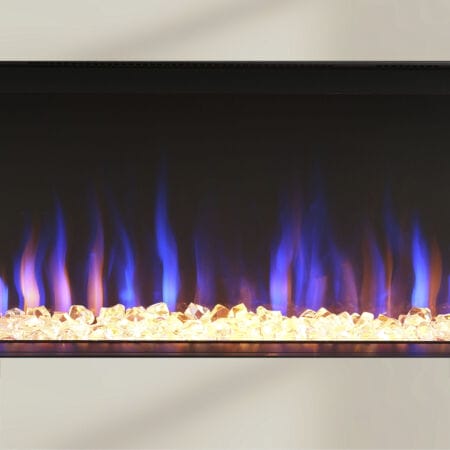Contents
ToggleWhat we'll cover...
An overview of designer radiators, with details on the best materials and accompanying elements for an energy efficient operation.
How to heat with style whilst saving
We’ll admit it: radiators haven’t always been the darlings of interior design. For decades, they’ve lurked beneath windows and behind sofas, doing their utmost not to be noticed. But somewhere along the line, the masses cottoned on to some BestHeating ideology that maybe, just maybe, heating could be beautiful.
But can designer radiators be energy efficient as well? Too much to ask, surely?
Well in fact, the rise of the designer radiator – sleek, sculptural, and unapologetically on show, has meant that these aren’t just appliances anymore. They’re features. And with a growing interest in home styling, they’ve become must-haves for anyone with one eye on Pinterest and the other on their thermostat.
But everyone still wants to know: do they just look the part, or can they perform too?
If you’re trying to cut your energy bills, shrink your carbon footprint, or simply avoid a system that overheats unused spaces and underheats you, it only makes sense that you’d want to know if these stylish statements can do the job properly.
Spoiler alert: they can. But this article will break down everything you need to know properly.
What is a designer radiator?
Before we dive into the merits of their efficiency, let’s clear something up: a designer radiator isn’t just a radiator with a posh paint job.
Designer radiators are units that combine function with form. They often feature:
- Architectural shapes (think: loops, vertical fins, or minimalist panels)
- Premium finishes (matte black radiators, brushed copper, stone-textured coatings)
- Unusual proportions (tall and thin, wide and low, wall-mounted like artwork)
They’re designed to complement or elevate interior design schemes, all the while delivering heat to the space. Crucially, they don’t compromise on performance for an attractive aesthetic.
And with so many people favouring renovation work in moving toward open-plan spaces, statement bathrooms, or multi-use rooms, designer rads have become more than just fashionable. Now, they can be seen as functional design solutions.
Are designer radiators energy efficient? The short answer
Yes, they certainly can be.
However, not to get too biblical, but not all designer radiators are created equal. Their energy efficiency depends on several key factors:
- The material they’re made from
- How they’re sized in relation to your room
- Whether they’re paired with smart heating controls
- How they fit into your overall heating setup
Get those elements right, and a designer radiator can match or beat the efficiency of a standard model without doubt.
1. Material: It's what's on the inside that counts
The material your radiator is made from has a huge impact on how well it is equipped to efficiently heat your space.
Aluminium – The smart minimalist’s choice
- Aluminium radiators heat up quickly and cool down just as fast, which is perfect for zoned or on-demand heating systems.
- Lightweight and incorporate low water content, therefore requiring less energy to run.
- Designs are often fully recyclable, earning big points for sustainability.
Mild steel – Solid and reliable
- Radiators made from mild steel will hold onto heat for longer, making it a great material to deliver consistent background warmth.
- Heats up slightly slower than aluminium but is widely available in a variety of designs.
- Good middle-ground option for most households.
Cast iron – It looks good, it looks fine, but heating up takes a little bit more time
- Cast iron radiators are fantastic for traditional aesthetics and slow, steady heat.
- Not ideal for quick-response systems or for teaming alongside smart heating technology.
- Better suited for period homes or low-temperature, continuous heating over longer time periods.
If your heating is set up to work with smart schedules, you should opt for radiators that respond quickly. Aluminium is your best bet for efficient, fast-paced heating in a stylish form.
2. Design features that help (or hinder)
Not all designer radiator shapes are just for show. Many are deliberately engineered to enhance performance.
Look for:
- Increased surface area: More surface = a more efficient heat transfer.
- Vertical radiators: These can prove especially helpful for convection in tall, narrow rooms or tight spaces like hallways.
- Looped or multi-panel styles: Such radiator models can help improve circulation and heat distribution.
Watch out for:
- Ultra-minimalist designs that clearly prioritise aesthetic appeal over surface area.
- “Sculptural” models that could struggle to deliver a high enough BTU output level. You can always check with our BTU Calculator.
We’re all for an artsy radiator that epitomises making heating cooler. Just remember, if the radiator looks like a gallery piece, make sure it’s got the numbers to back it up. Check the BTU output before you commit.
3. Sizing: The Goldilocks principle
Efficiency isn’t solely about materials; it’s also about providing the appropriate amount of heat for the space.
If you select an undersized radiator:
- It’ll need to work harder and run for longer, resulting in higher energy bills.
If you choose an oversized radiator:
- You’ll overheat the room or cycle the system inefficiently, again causing higher energy costs.
Solution:
Use our BTU calculator before you commit to your radiator purchase decision. It accounts for room size, insulation, windows, and other factors.
Designer radiators are available in all sorts of shapes and outputs, so once you know your BTU target, you can filter by style and performance to get the very best of both worlds.
4. Electric designer radiators: Energy efficiency on tap
Thinking of switching to electric radiators? Good news: there are plenty of efficient electric designer radiators that are perfect for:
- Homes without a gas central heating supply
- Rooms that aren’t connected to the main system (e.g. attics, garden buildings etc.)
- People intent on pairing radiators with solar or low-carbon energy tariffs
Look for:
- Lot 20 compliance: This means the radiator incorporates essential energy-saving features (such as timers, open window detection, adaptive start)
- Thermostatic control: Either integrated or smart-connected thermostats
- Quick heating elements: So you’re not running the radiator longer than necessary
Electric designer radiators are no longer an afterthought. In many cases, modern models are even more efficient to use than central heating radiators for smaller or occasional-use spaces.
5. Smart heating integration: Control is key
You’ve heard it before, and you’ll hear it again: smart controls are the secret sauce to sustainable heating.
Pairing your designer radiator with:
- Smart TRVs
- Zoned heating systems
- Programmable thermostats
- Heating apps or voice assistants
…means you’re only heating what you need, when you need to heat it.
Add features like geofencing, open window detection, and weather response, and you won’t just be saving energy – you’ll also be running a heating system that thinks ahead.
One thing that is often overlooked in heating efficiency is longevity.
In fact, many designer radiator models:
- Feature anti-corrosion coatings
- Are supplied with longer warranties
- Incorporate a robust, high-grade material finish
In summary, they will last longer, perform consistently, and won’t need replacing after just a few years. Better for the planet and for your wallet.
Plus, most designer radiators are easier to clean (thanks to simple shapes and fewer nooks for dust). This lends itself to better airflow and heat distribution over time.
7. Sustainably made = Greener choices
Looks, performance and materials are all well and good, but how a designer radiator is made is another factor to consider.
Many contemporary designer radiators’ have a construction involving:
- Recycled aluminium or sustainably sourced steel
- Low-emission powder coating as opposed to chemical-heavy paints
- Environmentally conscious manufacturing (low waste, renewable energy sources)
Our complete guide to sustainable home heating, somewhat unsurprisingly, offers a more in-depth exploration of the make-up of sustainable heating solutions.
Designer radiator efficiency traps to avoid
- Buying by looks alone: Always make a thorough check on the BTU output and spec sheet associated to your preferred radiator.
- Ignoring your room layout and use: Radiator placement, insulation, and room usage patterns matter.
- Skipping smart controls: A stylish radiator on 24/7 manual settings is the heating equivalent of driving a Ferrari in first gear.
Style meets substance with designer radiators from BestHeating
So, can designer radiators be energy efficient? Absolutely. In fact, when chosen carefully, many modern models can prove more efficient than their outdated counterparts – while upgrading the look of your home at the same time.
The key is to:
- Pick the right material
- Get the sizing right
- Pair with the proper controls
- Think about how, where, and when it will be used
John is a Research Specialist for the Best Heating Advice Centre, where for over nine years he has dedicated himself to demystifying home heating for our customers. He specialises in creating clear, data-driven guides and how-to articles by collaborating directly with our team of certified heating experts and product engineers.
His work, built on a foundation of journalistic research, has helped millions of readers make confident and informed decisions about their home heating. When he’s not breaking down the heat output differentials from radiators to heated towel rails, John fancies himself as a fine football and music connoisseur.










